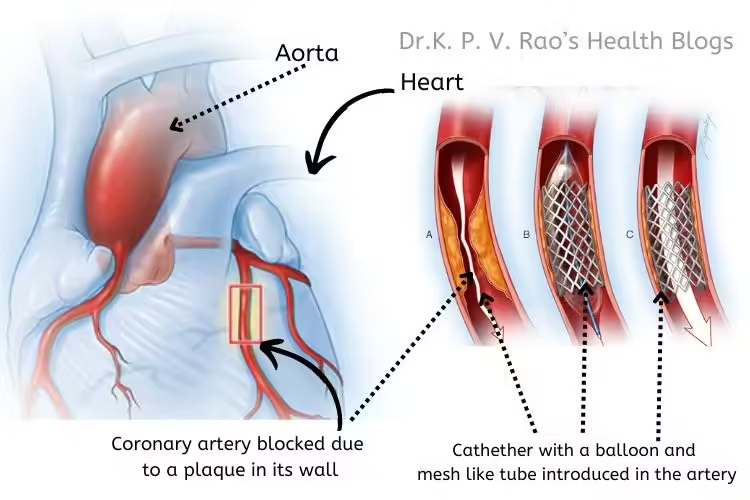
Introduction
In my final article, I described intimately what’s Percutaneous Transluminal Coronary Angioplasty or PTCA. On this article we’ll be taught somewhat bit extra about it.
Advantages of PTCA
Percutaneous transluminal coronary angioplasty or PTCA presents a number of important advantages for sufferers with coronary artery illness.

One of many foremost benefits is the development in blood circulate to the guts muscle, which may alleviate signs comparable to chest ache (angina) and shortness of breath.
By restoring satisfactory blood provide, PTCA may improve total coronary heart operate and high quality of life. Moreover, PTCA has the potential to scale back the danger of coronary heart assaults, significantly in sufferers with extreme blockages of their coronary arteries.
When in comparison with different therapy choices like coronary artery bypass surgical procedure (CABG), PTCA is much less invasive, involving solely a small incision to entry the coronary arteries. This minimally invasive nature usually leads to shorter hospital stays, faster restoration occasions, and decrease total healthcare prices.
Moreover, PTCA could be a preferable possibility for sufferers who are usually not appropriate candidates for open-heart surgical procedure because of different medical circumstances.
Dangers of Percutaneous Transluminal Coronary Angioplasty
Nevertheless, PTCA isn’t with out its dangers and problems. One of many major considerations is restenosis, which is the re-narrowing of the handled artery. This could happen inside months of the process and should necessitate extra interventions comparable to re-stenting or CABG.
One other threat is bleeding, significantly on the catheter insertion website, which may generally require medical consideration.
Opposed reactions to the distinction dye used through the process (angiography) are additionally potential, particularly in sufferers with pre-existing kidney issues or allergy symptoms.
Precautions and preventions
It’s essential to emphasise the significance of affected person choice and thorough threat evaluation in minimizing problems related to PTCA. Healthcare suppliers should consider every affected person’s particular person threat components and total well being standing to find out essentially the most applicable therapy method.
By fastidiously deciding on candidates for PTCA and using superior methods and applied sciences, the potential advantages of this process might be maximized whereas decreasing the probability of hostile outcomes.
Put up-Process Care and Lengthy-Time period Outcomes
Following a percutaneous transluminal coronary angioplasty (PTCA), fast post-procedure care is essential to make sure optimum restoration and stop problems.
As soon as accomplished, sufferers are usually monitored in a restoration room of the hospital, the place healthcare professionals carefully observe important indicators and the puncture website for any indicators of bleeding or different problems. It is not uncommon for sufferers to stay mendacity flat for a number of hours to reduce the danger of bleeding from the catheter insertion website.
Taking drugs on time is a vital facet of post-PTCA care. Sufferers are sometimes prescribed antiplatelet drugs, comparable to aspirin or clopidogrel, to forestall blood clots. These medicines play a pivotal function in sustaining the patency of the handled artery.
Moreover, life-style modifications, together with a heart-healthy weight loss program, common bodily exercise, smoking cessation, and weight administration, are important to boost the long-term success of the process.
Put up PTCA rehab
Cardiac rehabilitation applications, a program designed to convey again the affected person to his/her regular actions, provide a structured method to restoration, combining supervised train, training on heart-healthy dwelling, and counseling to scale back stress.
These applications have been proven to enhance cardiovascular health, cut back signs of coronary heart illness, and improve total high quality of life.
Common follow-up appointments with a heart specialist are additionally crucial to observe the affected person’s progress, regulate drugs as wanted, and detect any indicators of restenosis or different problems early.
Lengthy-term outcomes of PTCA are usually optimistic, with many sufferers experiencing important reduction from signs comparable to chest ache and an improved high quality of life. Research point out that the success charge of PTCA is excessive, with greater than 90% of procedures efficiently opening blocked arteries.
Nevertheless, there’s a threat of restenosis, the place the handled artery narrows once more over time. This happens in about 20-30% of sufferers however might be managed with repeat procedures or extra interventions.
To keep up coronary heart well being and stop future coronary artery illness, sufferers are suggested to undertake and keep wholesome life-style practices.
This contains consuming a balanced weight loss program wealthy in fruits, greens, and complete grains, partaking in common bodily exercise, managing stress successfully, and adhering to prescribed drugs and follow-up care. By doing so, sufferers can considerably cut back their threat of recurrent coronary heart points and revel in a greater high quality of life post-PTCA.
Conclusion
The significance of PTCA in fashionable cardiology can’t be overstated. It presents a much less invasive different to open-heart surgical procedure, with shorter restoration occasions and fewer problems.
Because the prevalence of coronary artery illness continues to rise, the function of PTCA in managing this situation turns into more and more important.
By way of ongoing analysis and technological developments, PTCA continues to evolve, providing new hope and improved outcomes for sufferers with coronary artery illness.
Remaining Phrases
We are actually coming to the top of therapy for blocked coronary heart arteries. I hope you may have gained quantity of data relating to coronary heart angiography in addition to coronary heart angioplasty.
My subsequent article will probably be on a dietary product that’s identified to forestall coronary heart disease- Olive Oil.
Adios.